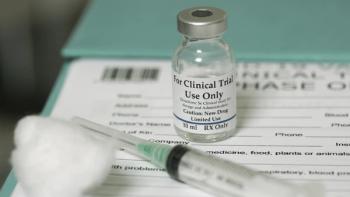
Opus Genetics doses first patient in phase 3 LYNX-3 trial evaluating phentolamine ophthalmic solution 0.75%
The trial will evaluate the solution in treating significant, chronic night driving impairment in keratorefractive patients with reduced mesopic vision.
Opus Genetics has dosed the first patient in LYNX-3, its pivotal phase 3 clinical trial of phentolamine ophthalmic solution 0.75% in treating significant, chronic night driving impairment in keratorefractive patients with reduced mesopic vision.
Night-vision disturbances, which can include glare, halos, and starbursts, are common in some patients after keratorefractive procedures such as LASIK, but no FDA-approved treatment options are currently available.
“Dosing the first patient in LYNX-3 is a significant milestone for our phentolamine program, which already has 1 approved indication for the reversal of drug-induced mydriasis, positive phase 3 data in potentially treating presbyopia, and now an ongoing phase 3 trial for keratorefractive patients with visual disturbances under mesopic, low-contrast conditions,” said George Magrath, MD, CEO of Opus Genetics in a press release from the company.
LYNX-3 is a multicenter, randomized, double-masked, placebo-controlled phase 3 trial that will enroll approximately 200 adults with documented decreased visual acuity in mesopic (low-light) conditions following keratorefractive surgery, including LASIK, PRK, SMILE, and RK. Participants will be randomly assigned 1:1 to receive once-daily evening dosing of phentolamine ophthalmic solution 0.75% or placebo for approximately 2 weeks.
The primary end point is the percentage of participants achieving a ≥15-letter Early Treatment Diabetic Retinopathy Study (ETDRS) (≥3-line) improvement from baseline in mesopic low-contrast visual acuity (mLCVA) in the study eye at day 15.
Phentolamine ophthalmic solution 0.75% is a nonselective alpha-1 and alpha-2 adrenergic antagonist to reduce pupil size. The company noted that phentolamine ophthalmic solution 0.75% blocks the alpha-1 receptors found on the radial iris dilator muscles, which are activated by the alpha-1 adrenergic receptors, without affecting the ciliary muscle, which reduces risks such as retinal tears or detachment associated with older parasympathomimetic agents.
LYNX-3 is the second of 2 pivotal phase 3 studies, and is being conducted under a Special Protocol Assessment (SPA) and follows the same study design and patient population as the first study, LYNX-2.
LYNX-2 was a randomized, double-masked, placebo-controlled trial in 199 patients who had previously undergone keratorefractive surgery and reported decreased visual acuity under mesopic low-contrast conditions. Patients were randomly assigned to receive either phentolamine or placebo, which was self-administered in both eyes nightly, treated, and observed over 6 weeks.
The trial met its primary end point of a gain of 3 lines, or 15 letters, or more of distance vision improvement on a low-contrast chart in low-light conditions after 15 days of dosing. In LYNX-2, 17.3% of patients treated with phentolamine ophthalmic solution 0.75% achieved a ≥15-letter Early Treatment Diabetic Retinopathy Study (ETDRS) (≥3-line) improvement in Mesopic Low Contrast Distance Visual Acuity (mLCVA) at Day 15, compared with 9.2% in the placebo group (P < .05).
The company's phase 3 VEGA-3 trial also evaluated phentolamine ophthalmic solution 0.75% for the treatment of presbyopia and met its primary end point as announced with other positive topline results in June 2025. The VEGA-3 trial met its primary end point, with a statistically significant 27.2% of participants treated with the solution achieving a ≥15-letter improvement in binocular distance-corrected near visual acuity, with less than a 5-letter loss in binocular best-corrected distance visual acuity at 12 hours post dose on day 8, compared with 11.5% of patients on placebo (P < .0001). Additionally, the trial met key secondary efficacy end points.3
References:
Opus Genetics doses first patient in pivotal lynx-3 phase 3 trial evaluating phentolamine ophthalmic solution 0.75% in keratorefractive patients with visual disturbances under mesopic, low-contrast conditions. Published September 4, 2025. Accessed September 8, 2025.
https://www.globenewswire.com/news-release/2025/09/04/3144432/0/en/Opus-Genetics-Doses-First-Patient-in-Pivotal-LYNX-3-Phase-3-Trial-Evaluating-Phentolamine-Ophthalmic-Solution-0-75-in-Keratorefractive-Patients-With-Visual-Disturbances-Under-Mesop.html Harp MD. Opus Genetics releases topline results from LYNX-2 evaluating phentolamine ophthalmic solution 0.75%. Published June 2, 2025. Accessed September 8, 2025.
https://www.ophthalmologytimes.com/view/opus-genetics-releases-topline-results-from-lynx-2-evaluating-phentolamine-ophthalmic-solution-0-75- Opus Genetics Announces VEGA-3 Phase 3 Trial Met its Primary Endpoint for Phentolamine Ophthalmic Solution 0.75% for the Treatment of Presbyopia. News release. Opus Genetics. June 26, 2025. Accessed September 8, 2025. https://ir.opusgtx.com/press-releases/detail/490/opus-genetics-announces-vega-3-phase-3-trial-met-its-primary-endpoint-for-phentolamine-ophthalmic-solution-0-75-for-the-treatment-of-presbyopia
Newsletter
Want more insights like this? Subscribe to Optometry Times and get clinical pearls and practice tips delivered straight to your inbox.















































.png)


